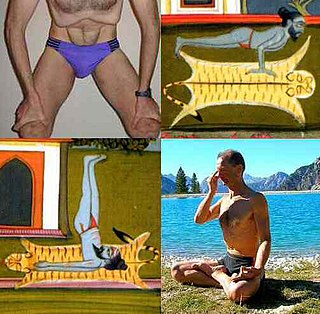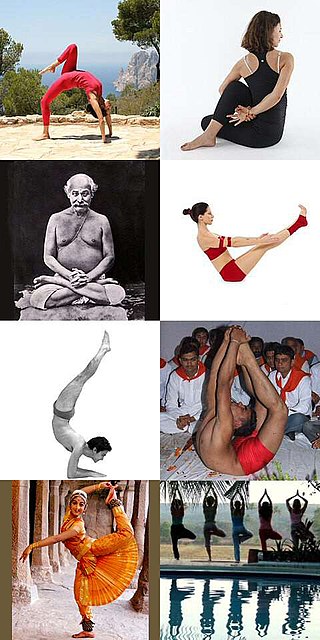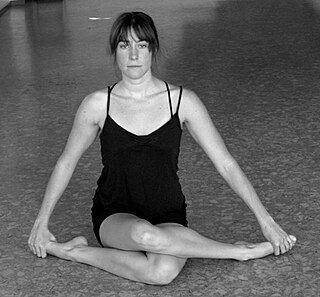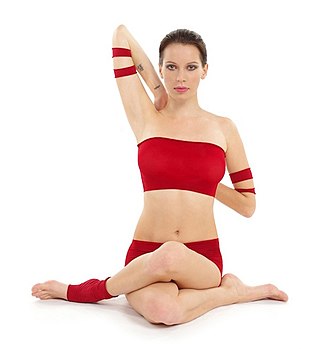
Hatha yoga is a branch of yoga that uses physical techniques to try to preserve and channel vital force or energy. The Sanskrit word हठ haṭha literally means "force", alluding to a system of physical techniques. Some hatha yoga style techniques can be traced back at least to the 1st-century CE, in texts such as the Hindu Sanskrit epics and Buddhism's Pali canon. The oldest dated text so far found to describe hatha yoga, the 11th-century Amṛtasiddhi, comes from a tantric Buddhist milieu. The oldest texts to use the terminology of hatha are also Vajrayana Buddhist. Hindu hatha yoga texts appear from the 11th century onward.

An āsana is a body posture, originally and still a general term for a sitting meditation pose, and later extended in hatha yoga and modern yoga as exercise, to any type of position, adding reclining, standing, inverted, twisting, and balancing poses. The Yoga Sutras of Patanjali define "asana" as "[a position that] is steady and comfortable". Patanjali mentions the ability to sit for extended periods as one of the eight limbs of his system. Asanas are also called yoga poses or yoga postures in English.

Satyananda Saraswati, was a Sanyasi, yoga teacher and guru in both his native India and the West. He was a student of Sivananda Saraswati, the founder of the Divine Life Society, and founded the Bihar School of Yoga in 1964. He wrote over 80 books, including the popular 1969 manual Asana Pranayama Mudra Bandha.

Vishnudevananda Saraswati was an Indian yoga guru known for his teaching of asanas, a disciple of Sivananda Saraswati, and founder of the International Sivananda Yoga Vedanta Centres and Ashrams. He established the Sivananda Yoga Teachers' Training Course, possibly the first yoga teacher training programs in the West. His books The Complete Illustrated Book of Yoga (1960) and Meditation and Mantras (1978) established him as an authority on Hatha and Raja yoga. Vishnudevananda was a peace activist who rode in several "peace flights" over places of conflict, including the Berlin Wall prior to German reunification.

Sivananda Yoga is a spiritual yoga system founded by Vishnudevananda; it includes the use of asanas but is not limited to them as in systems of yoga as exercise. He named this system, as well as the international Sivananda Yoga Vedanta Centres organization responsible for propagating its teachings, after his guru, Sivananda with the mission 'to spread the teachings of yoga and the message of world peace' which has since been refined to 'practice and teach the ancient yogic knowledge for health, peace, unity in diversity and self-realization.'

Yin Yoga is slow-paced style of yoga as exercise, incorporating principles of traditional Chinese medicine, with asanas (postures) that are held for longer periods of time than in other styles. Advanced practitioners may stay in one asana for five minutes or more. The sequences of postures are meant to stimulate the channels of the subtle body known as meridians in Chinese medicine and as nadis in Hatha yoga.

Gomukhasana or Cow Face Pose is a seated asana in hatha yoga and modern yoga as exercise, sometimes used for meditation.

Paulie Zink is an American martial arts champion, Daoyin teacher and well known practitioner of Monkey Kung Fu. He founded Yin yoga which is also known as Yin and Yang Yoga.

Yoganidrasana, or Yogic Sleep Pose is a reclining forward-bending asana in modern yoga as exercise. It is sometimes called Supta Garbhasana. The name Dvi Pada Sirsasana is given to the balancing form of the pose.

Yoga as exercise is a physical activity consisting mainly of postures, often connected by flowing sequences, sometimes accompanied by breathing exercises, and frequently ending with relaxation lying down or meditation. Yoga in this form has become familiar across the world, especially in the US and Europe. It is derived from medieval Haṭha yoga, which made use of similar postures, but it is generally simply called "yoga". Academics have given yoga as exercise a variety of names, including modern postural yoga and transnational anglophone yoga.

Hatha Yoga: The Report of a Personal Experience is a 1943 book by Theos Casimir Bernard describing what he learnt of hatha yoga, ostensibly in India. It is one of the first books in English to describe and illustrate a substantial number of yoga poses (asanas); it describes the yoga purifications (shatkarmas), yoga breathing (pranayama), yogic seals (mudras), and meditative union (samadhi) at a comparable level of detail.

Mindful Yoga or Mindfulness Yoga combines Buddhist-style mindfulness practice with yoga as exercise to provide a means of exercise that is also meditative and useful for reducing stress. Buddhism and Hinduism have since ancient times shared many aspects of philosophy and practice including mindfulness, understanding the suffering caused by an erroneous view of reality, and using concentrated and meditative states to address such suffering.
Sarah Powers is a yoga teacher. She co-founded the Insight Yoga Institute and created Insight Yoga, a combination of yoga, transpersonal psychology and Buddhist and Taoist philosophy, described in her 2008 book of the same name. She was closely involved with the creation of Yin Yoga.
Frank Jude Boccio is a teacher and one of the originators of mindful yoga. He is known both for his teaching in centres across America, and for his 2004 book Mindfulness Yoga: The Awakened Union of Breath, Body and Mind, which describes a practice that combines yoga as exercise and Buddhist meditational practice.
Stephen Cope is a psychotherapist, Kripalu Yoga teacher, and author of several books on yoga and meditation. He is the founder of the Kripalu Institute for Extraordinary Living.
Yoga teacher training is the training of teachers of yoga as exercise, consisting mainly of the practice of yoga asanas, leading to certification. Such training is accredited by the Yoga Alliance in America, by the British Wheel of Yoga in the United Kingdom, and by the European Union of Yoga across Europe. The Yoga Alliance sets standards for 200-hour and 500-hour Recognized Yoga Teacher levels, which are accepted in America and other countries.

A yoga brick or yoga block is a smooth block of wood or of firm but comfortable material, such as hard foam rubber or cork, used as a prop in yoga as exercise.

The science of yoga is the scientific basis of modern yoga as physical exercise in human sciences such as anatomy, physiology, and psychology. Yoga's effects are to some extent shared with other forms of exercise, though it differs in the amount of stretching involved, and because of its frequent use of long holds and relaxation, in its ability to reduce stress. Yoga is here treated separately from meditation, which has effects of its own, though yoga and meditation are combined in some schools of yoga.

Props used in yoga include chairs, blocks, belts, mats, blankets, bolsters, and straps. They are used in postural yoga to assist with correct alignment in an asana, for ease in mindful yoga practice, to enable poses to be held for longer periods in Yin Yoga, where support may allow muscles to relax, and to enable people with movement restricted for any reason, such as stiffness, injury, or arthritis, to continue with their practice.
















